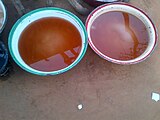Burukutu
Burukutu is an alcoholic beverage, brewed from the grains of Guinea corn (Sorghum bicolor) and millet (Pennisetum glaucum).[1] The alcoholic beverage is often produced in Tropical African countries such as Nigeria, Kenya, Ethiopia and Burundi as one of the major traditional and local alcoholic drink. It is commonly consumed in Northern Guinea savanna region of Nigeria, Ghana and Republic of Benin.[2]
Production
Burukutu production involves five basic stages, which includes: steeping, malting, mashing, fermentation and maturation.[3] The production begins by malting, which involves the conversion of the Guinea corn or millet grains into malt and this takes place on a malting floor.[4] This process is followed by steeping, which involves the soaking of the grains in water for at least three days to allow the grain to absorb moisture and to begin to sprout.[5] When the grain has absorbed enough moisture, it is transferred to the malting floor, where it is constantly turned over for around five days while it is air-dried.[6] This procedure is followed by mashing in which the milled grain known as the "grain bill" (malted grain) is mixed with water known as "liquor" and heating the mixture.[7] This process allows the enzymes in the grain bill to decompose the starch in the grain into sugars (maltose) to form a wort.[8] The product is allowed to ferment using the sugar fungi form of yeast and allow maturation for 2 days or 48 hours.[9]
Gallery
See also
- Umqombothi, Chibuku and Munkoyo or 'Ibwatu' in Zambia.
References
- ^ Thomas-Emeagwali, Gloria (1992). The historical development of science and technology in Nigeria. ISBN 9780773492141. Retrieved June 30, 2015.
{{cite book}}:|work=ignored (help) - ^ Solieri, Laura; Giudici, Paolo (29 August 2009). Vinegars of the World. ISBN 9788847008663. Retrieved June 30, 2015.
{{cite book}}:|work=ignored (help) - ^ "Fermentation of Sorghum Using Yeast (Saccharomyces cerevisiae) As a Starter Culture for Burukutu Production". archive.org. Retrieved June 30, 2015.
- ^ "Journal of Institute of Brewing". books.google.co.uk. 2002. Retrieved June 30, 2015.
- ^ Thomas-Emeagwali, Gloria (1993). African system of science technology& art:The Nigerian experience. ISBN 9780907015765. Retrieved June 30, 2015.
{{cite book}}:|work=ignored (help) - ^ Ray, R. C. (10 January 2006). Microbial Biotechnology in Agriculture and Aquaculture. ISBN 9781578084432. Retrieved June 30, 2015.
{{cite book}}:|work=ignored (help) - ^ Alimba, J. O. (2003). Socioeconomic consequence of technological change of Rural. ISBN 9789966916327. Retrieved June 30, 2015.
{{cite book}}:|work=ignored (help) - ^ "Chemoreception abstract". books.google.co.uk. 1988.
- ^ Maisamari, Auta. "Southern Kaduna:a people misunderstood". books.google.co.uk.




